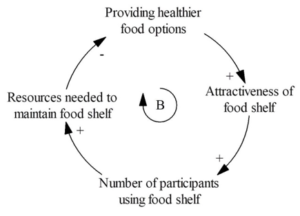By Nishesh Chalise, PhD LGSW
Dr. Chalise is an Assistant Professor in the department of social work at Augsburg University.
A few weeks ago I had the opportunity to talk with Campus Compact’s Newman Civic Fellows about systems thinking as a tool for solving complex public problems. The goal of the Newman Civic Fellowship is to provide emerging leaders with the tools they need to serve as effective agents of social change. Tackling difficult social issues requires an understanding that problems are complex and require a collective effort to solve. Systems thinking is one such approach that embraces the complexity of the problem. Rather than trying to understand parts of a system, it aims to identify and develop knowledge about the interconnectedness of various parts and the resulting system behavior.
Over the past year, I have been part of a community based research team in Minneapolis that includes two community center staff members, food shelf participants, and representatives from two local foundations. Developing a holistic view of the system requires bringing diverse groups of people together, since people experience different parts of the system and interact with it differently. It is important to provide space for people whose lives are embedded in the problem at the front and center because they navigate those systems as part of their daily lives. This community based systems thinking approach aims to provide insights about the system while giving voice to those who would otherwise be unheard.
A member of the food security community based research team shared that her family of four lives in a one-bedroom apartment. They want to move from the apartment building because of the rampant violence in the area. She worries about her family’s safety. However, moving to a safer neighborhood will mean allocating more money from her already stretched budget to housing. She is faced with a choice between living in a safer neighborhood and being able to feed her family. For her and many other families like hers, food programs are a life saver. Her story is not uncommon. Approximately 25% of Americans participated in 1 or more of the 15 food and nutrition assistance program funded by the federal government. A significant number of people depend on food shelves, and that number is increasing. During the first six months of 2016, there were 1.6 million visits to food shelves in the state of Minnesota, an increase of 15% from 2012. Similarly in Hennepin County (project area), food shelves have experienced a 22.43% increase in visits since 2012.
The increase in use over the past few years coincides with a commitment by food shelves to provide healthier food options. Combined with their commitment to provide culturally-inclusive food and serve participants with dignity, the food shelves are attracting more participants, including from adjacent counties. At the same time, the budget is tighter than ever due to funding cuts, which resulted in closure of two food shelves in the area. The fact that food shelves are just a band-aid, albeit an utterly necessary one, is not lost either. Families continue to come to the food shelf for several years because they don’t have an alternative. The task for the community based research team, therefore, is to figure out how to provide quality services to more people with fewer resources.
To do “systems thinking” simply means to explicate the organization of the system and how that produces system’s behaviors. More specifically, the goal is to develop a visual representation of the dynamic discussed above. For example, think about the food shelves’ effort to provide healthier food options. As the food shelves provide healthier food options, it increases their attractiveness and draws more people. That requires more resources to provide healthier food for more people, creating an opposing force to the food shelves’ well-intentioned effort. This narrative constitutes a balancing feedback loop (B) (see figure below), which works to control the behavior of the system. A thermostat works based on a balancing feedback loop where it controls the flow of warm and cold air to maintain temperature.
In a system, every action has multiple consequences. So while a solution to the problem could be securing more resources through grant making and fundraising, this can further exacerbate the problem as an increase in resources eventually leads to providing services for more people. Even the act of grant writing, fundraising, and consequently reporting on the grant will divert resources away. The role of systems thinking is to help stakeholders understand how the system is working so they can be better equipped to design effective interventions.
Food security is a complex issue and will require a collaborative effort from many stakeholders, including people who are food insecure, community centers, funders, policy makers, and scholars. Part of the reason collaborative efforts don’t work is because everyone perceives the system from their own perspective. They see their particular component of the system and have their own language to talk about it. A community based systems thinking approach integrates the various system components and creates a shared language to talk about the system. In the process, stakeholders learn from each other and understand how the system they see is interconnected with the daily lives and activities of people. With systems thinking, people from different walks of life co-create a shared understanding of the system that they could not comprehend alone; which is essential when tackling dynamic, complex problems.
This blog was originally posted on campus compact:
https://compact.org/resource-p
